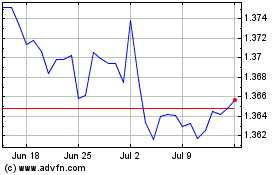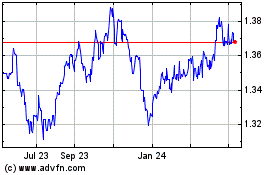U.S. Dollar Slides Against Majors
March 26 2015 - 6:22AM
RTTF2
The U.S. dollar weakened against the other major currencies in
the early European session on Thursday, in the wake of
disappointing U.S. data overnight.
Data from the Commerce Department showed Wednesday that U.S.
durable goods orders fell by 1.4 percent in February following a
downwardly revised 2.0 percent increase in January. Economists had
expected orders to climb by 0.7 percent compared to the 2.8 percent
jump that had been reported for the previous month.
Moreover, Chicago Fed President Charles Evans comments at the
Official Monetary and Financial Institutions Forum in London also
weighed on the currency.
Charles Evans said that there no need to raise interest rates at
a time when inflation is so low. "I see no compelling reason for us
to be in a hurry to tighten financial conditions until then," he
said.
Evans said, "The stronger dollar presents a clear
disinflationary pressure through its influence on U.S. import
prices."
Last week, the Fed's official policy statement removed a
reference to being "patient" before tightening. Also, the Fed is
now likely to hike interest rates later rather than sooner,
weighing on the currency.
Traders await the U.S. weekly jobless claims and U.S. services
PMI due later today, which may give more insights about the
economy.
In the European trading today, the U.S. dollar fell to 118.32
against the yen for the first time since February 20, from an early
high of 119.56. If the greenback extends its downtrend, it is
likely to find support around the 116.58 area.
Pulling away from an early high of 1.2532 against the Canadian
dollar and against the euro, the greenback slipped to a near 3-week
lows of 1.2411 and 1.1051, respectively. The next possible downside
target for the greenback lies around 1.22 against the loonie and
1.11 against the euro.
Against the pound, the greenback edged down to 2-day low of
1.4910 from an early high of 1.4871. The greenback is likely to
find support around the 1.52 area.
The greenback depreciated to nearly a 4-week low of 0.9518
against the Swiss franc, from an early high of 0.9505. The
greenback may test support near the 0.92 region.
Against the Australia and New Zealand dollars, the greenback
edged down to 0.7880 and 0.764 from early 3-day highs of 0.7799 and
0.7569, respectively. On the downside, 0.80 against the aussie and
0.78 against the kiwi are seen as the next support levels for the
greenback.
Looking ahead, U.S. weekly jobless claims for the week ended
March 21 and Markit's U.S. PMI reports for March are slated for
release in the New York session.
At 9:00 am ET, U.S. Federal Reserve Bank of Atlanta President
Dennis Lockhart will deliver a speech about the economic outlook
and monetary policy at the Engage International Investment
Education Symposium, in Detroit.
Subsequently, European Central Bank president Mario Draghi will
address the Italian parliament's finance and EU policy committees
in Rome at 9:15 am ET. After 15 minutes, Bank of Canada Governor
Stephen Poloz is expected to speak at the Canada-UK Chamber of
Commerce, in London.
At 1:30 pm ET, Bank of England Governor Mark Carney will hold a
press conference about his role as Chair of the Financial Stability
Board, in Frankfurt. After half-an-hour, Swiss National Bank member
Fritz Zurbrugg will deliver a speech about monetary policy after
the cap at the Money Market Event, in Zurich.
US Dollar vs CAD (FX:USDCAD)
Forex Chart
From Mar 2024 to Apr 2024

US Dollar vs CAD (FX:USDCAD)
Forex Chart
From Apr 2023 to Apr 2024
